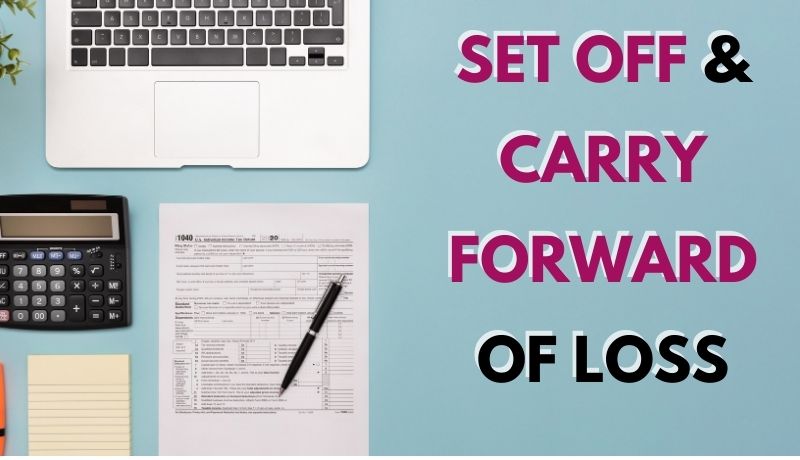In this article, we will discuss Set Off & Carry Forward of Losses. Income tax law in India provides taxpayers with some benefits of setting off & carrying forward the incurred losses. Here are the details:
1. Set off of losses –
It means adjusting the losses against the profit or income of that particular year. Losses that are not set off against income in the same year can be carried forward to the subsequent years for set off against income of those years. A set-off could be an intra-head set-off or an inter-head set-off.
[A]. Intra-head set off –
Losses from one source of income can be set off against income from another source under the same head of income.
For example:
a) Loss from the Manufacturing Business can be set off against Profit from the Textile Business, where the Manufacturing Business is one source & Textile Business is another source & common head of income is “Business”.
b) Set off of loss from self-occupied property against profit from another rented house property is an intra-head set-off.
Exceptions of Intra-head set-off –
1). You can set off a loss under the head ‘house property’ against any other income head to the extent of Rs. 2,00,000 only for any assessment year
2). Losses from a Speculative Business will only be set off against the profit of the speculative business. It cannot adjust the losses of speculative business with the income from any other business or profession.
3). Loss from an activity of owning and maintaining race-horses will be set off only against the profit from an activity of owning and maintaining race-horses.
4). Long-term capital loss (LTCL) will only be adjusted towards long-term capital gains. However, a short-term capital loss can be set off against both long-term capital gains and short-term capital gains (STCG) (i.e., LTCL cannot be set off against STCG).
5). Losses from a specified business under section 35AD will be set off only against profit of specified businesses under section 35AD. But the losses from any other businesses or profession can be set off against profits from the specified businesses.
6). Losses from trading in Cryptocurrency & other Virtual Digital Assets (VDA) – You cannot set off loss from the transfer of cryptocurrency, NFT, or VDA against any other income. Further, you cannot set off loss under any other head of income against profit on transfer of cryptocurrency, NFT, or VDA. You also cannot carry forward such loss to future years.
[B]. Inter-head set off –
After the intra-head adjustments, taxpayers can set off remaining losses against income from other heads.
For example – Set off of loss from self-occupied house property against salary income. Before making the inter-head set-off, the taxpayer has to first make the intra-head set-off.
Few more examples of an inter-head set off of losses are:
- Loss from house property can be set off against income under any head.
- Business loss other than speculative business & specified business u/s 35AD can be set off against any head of income except income from salary.
Note – following losses can’t be set off against any other head of income:
a) Speculative Business loss
b) Specified Business loss u/s 35AD
c) Capital Losses (Long term or Short-term)
d) Losses from an activity of owning and maintaining race-horses
2. Carry Forward of Losses –
After making the adjustments of intra-head and inter-head losses, there could still be possibility of unadjusted losses. These unadjusted losses can be carried forward to future years for adjustments against income of these years. The rules regarding carry forward are slightly different for different heads of income.
[A]. Losses from House Property –
- Can be carry forward up to next 8 assessment years from the assessment year in which the loss was incurred
- Can be adjusted only against Income from house property
- Can be carried forward even if the return of income under section 139(1) has been filed after the due date.
[B]. Losses from Regular Business (other than Speculative Business & Specified Business u/s 35AD) –
- Can be carry forward up to next 8 assessment years from the assessment year in which the loss was incurred
- Can be adjusted only against Income from business or profession
- Not necessary to continue the business at the time of set off in future years.
- Cannot be carried forward if the return is not filed within the original due date as specified under section 139(1).
[C]. Speculative Business loss –
- Can be carry forward up to next 4 assessment years from the assessment year in which the loss was incurred
- Can be adjusted only against Income from speculative business
- Not necessary to continue the business at the time of set off in future years.
- Cannot be carried forward if the return is not filed within the original due date as specified under section 139(1).
[D]. Specified Business loss under section 35AD –
- No time limit to carry forward the losses from specified business u/s 35AD
- Can be adjusted only against Income from specified business u/s 35AD
- Not necessary to continue the business at the time of set off in future years
- Cannot be carried forward if the return is not filed within the original due date as specified under section 139(1).
[E]. Capital Losses –
- Can be carry forward up to next 8 assessment years from the assessment year in which the loss was incurred
- Cannot be carried forward if the return is not filed within the original due date as specified under section 139(1)
- Long-term capital losses can be adjusted only against long-term capital gains
- Short-term capital losses can be set off against long-term capital gains as well as short-term capital gains
- The order of adjusting STCL & LTCL is not prescribed in the income tax act. Hence, STCL & LTCL are first to be adjusted against that Capital Gain which has the highest tax rate.
[F]. Losses from owing & maintaining race horses –
- Can be carry forward up to next 4 assessment years from the assessment year in which the loss was incurred
- Cannot be carried forward if the return is not filed within the original due date as specified under section 139(1)
- Can be set off only against Income from owing & maintaining race horses only
[G]. Unabsorbed Depreciation u/s 32(2) –
- No time limit to carry forward the unabsorbed depreciation u/s 32(2)
- Can be carried forward even if the return is not filed within the original due date as specified u/s 139(1)
- Can be set off only against any head of income except salary income
[H]. Note for all the 7 points mentioned above –
- Any assessee incurring a loss from a source, income from which is otherwise exempt from tax, cannot set off these losses against profit from any taxable source of Income
- Losses cannot be set off against casual income i.e. crossword puzzles, winning from lotteries, races, card games, betting etc.
Example of Set off & Carry Forward of Loss
Question –
- FY 2020-21 (AY 2021-22)
Non-Speculative Business Loss: Rs 4,80,000
Speculative Business Income: Rs 1,20,000
House Property Income: Rs 3,00,000 - FY 2021-22 (AY 2022-23)
Speculative Business Income: Rs 50,000
Non-Speculative Business Income: Rs 1,60,000
Solution –
- FY 2020-21 (AY 2021-22)
The taxpayer can set off Non-Speculative Business Loss in the following order:- Speculative Business Income (Intra-head set off) – Rs 1,20,000
- House Property Income (Inter-head set off) – Rs 3,00,000
- Carry Forward of Non-Speculative Business Loss to future years – Rs 60,000 (4,80,000-1,20,000-3,00,000)
- FY 2021-22 (AY 2022-23)
The taxpayer can set off Non-Speculative Business Loss in the following order:- Carry Forward Loss – Rs 60,000
- Non-Speculative Business Income – Rs 1,60,000
- Speculative Business Income – Rs 50,000
Happy readings!
Disclaimer: The information contained in this website is provided for informational purposes only, and should not be construed as legal/official advice on any matter. All the instructions, references, content, or documents are for educational purposes only and do not constitute legal advice. We do not accept any liabilities whatsoever for any losses caused directly or indirectly by the use/reliance of any information contained in this article or for any conclusion of the information.









